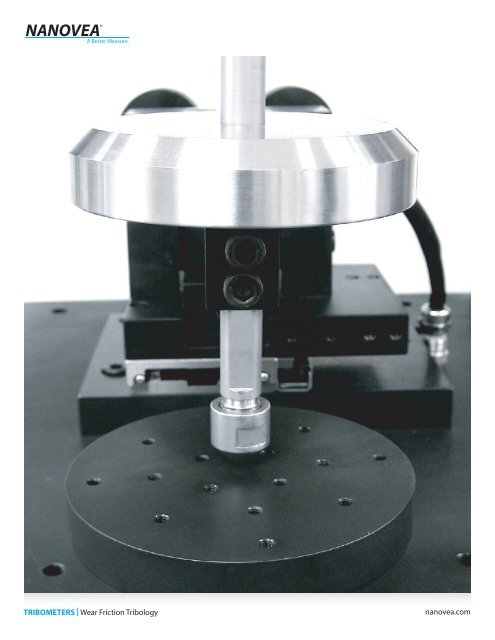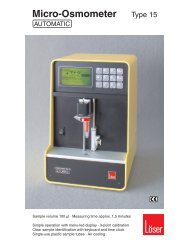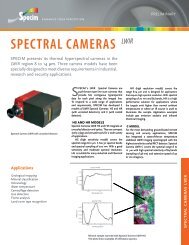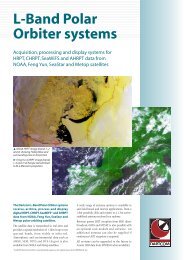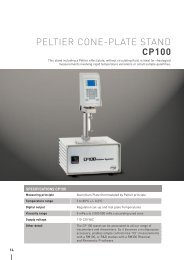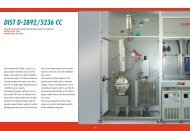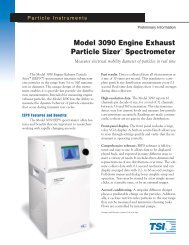nanovea.com TRIBOMETERS | Wear Friction Tribology
nanovea.com TRIBOMETERS | Wear Friction Tribology
nanovea.com TRIBOMETERS | Wear Friction Tribology
You also want an ePaper? Increase the reach of your titles
YUMPU automatically turns print PDFs into web optimized ePapers that Google loves.
<strong>TRIBOMETERS</strong> | <strong>Wear</strong> <strong>Friction</strong> <strong>Tribology</strong><br />
<strong>nanovea</strong>.<strong>com</strong>
TRIBOMETER INTRO<br />
The Nanovea Tribometer (Table Top 60 x 39 x 62 cm) offers precise and repeatable wear and<br />
friction testing using pin-on-disk and linear modes. Designed, at the core, with a high quality<br />
motor and a 20bit position encoder, the Tribometer provides access to an unmatched range of<br />
rotational speeds from 0.01 to 2000rpm. High resolution means that data can be accurately<br />
recorded at specified interval of time or position (>0.006°). The motor has an integrated selftuning<br />
system which ensures that speed remains calibrated through time. Full and precise control<br />
of the motor ensures that a series of step speeds can be run continuously during the tests.<br />
For wear measurement, weight loss can be measured using a sensitive weight scale before<br />
and after the test. Furthermore, an LVDT can be attached to the measuring arm to record<br />
depth during the test. This gives the possibility to follow the change of wear rate versus time.<br />
<strong>Friction</strong> force is measured directly with a stiff load cell which offers high resolution with<br />
excellent mechanical and thermal stability;<br />
unlike other systems that rely only on LVDT for<br />
friction measurement. A ball, pin or flat holder is attached to the measuring arm which can be precisely<br />
positioned to a resolution of 2.5micron using the standard motorized table. Several testing options are<br />
available to closely match real environment conditions. The Tribometer <strong>com</strong>es standard with an acrylic<br />
enclosure and attached valves which brings inert and other gases to achieve a controlled environment. An<br />
optional humidifier and dehumidifier module allows precise control of the humidity levels. For high<br />
temperature pin on disk, up to 900°C, an oven allows control to better than 1°C. A linear heating plate is<br />
used for reciprocating test up to 300°C. Various cups are available for controlled liquid testing. Tests can<br />
either be done under full immersion or using the Lubrication system with drop by drop or control spray. A<br />
liquid heating module is also available to provide controlled liquid heating up to 150°C. To precisely measure wear track volume, a full 3D non-contact<br />
optical profiler, installed on the Tribometer platform, is available to quantify wear loss in a fast and convenient way without removing the sample. The<br />
Tribometer software uses this information and the test parameters to calculate a precise wear rate for the specific test. The profiler, which has extended<br />
capability, can also be used for surface topography measurements including roughness. A Flexible mobile imaging option allows zoom-in ability to record<br />
the sample surface for playback review.<br />
TRIBOMETER TESTING<br />
Pin-on-Disk (ASTM G99) | Pin-on-Disk operates on the following principle: a flat, pin or ball is loaded<br />
onto a test sample with a precisely known weight and at a specific position from the center to create a<br />
circular wear track as the bottom plate rotates. The friction coefficient is determined during the test by<br />
measuring the deflection of the direct load cell. <strong>Wear</strong> rates for the pin and the disk are calculated from the<br />
volume of material lost during the test.<br />
Linear Reciprocating (ASTM G133) | The Linear Module<br />
reproduces the reciprocating motion typical in many real-world<br />
mechanisms. The instrument produces a friction coefficient for both the forward and backward movements<br />
of the stroke. This reciprocating technique is very useful for studying the static coefficient of friction over<br />
time, as opposed to the kinetic coefficient measured with the Pin-on-Disk wear testing geometry. The<br />
software allows change of friction at any specific point along one lap to be plotted versus time.<br />
CONTROLLED ENVIRONMENT TESTING<br />
Humidity Control System | A standard acrylic enclosure makes it possible to use specific salt baths to create various humid atmospheres. A full<br />
humidity control system is available for applications requiring a higher level of control. This advanced option includes a dehumidification and<br />
humidification apparatus in addition to the automatic humidity controller with sensor.
CONTROLLED ENVIRONMENT TESTING<br />
Pin-on-Disk High Temperature (Up to 900°C) | Analysis of friction & wear properties at elevated<br />
temperatures is be<strong>com</strong>ing increasingly important, as engineers face ever more challenging materials in<br />
applications such as the design of advanced fuel efficient <strong>com</strong>bustion engines and power plants. The High<br />
Temperature removable heating element enables the rotating disk to reach temperatures up to 900°C; suitable<br />
for use in the study of high temperature ceramics, lubricants, oils, additives and self-lubricating materials. Two<br />
level of oven are available, one for temperature up to 600°C and one for elevated temperatures up to 900°C. A<br />
thermocouple measures temperature directly on the ball or in the oven close to the sample surface. This is<br />
more accurate than measuring remotely from under the sample or close to the heating element.<br />
Linear High Temperature (Up to 300°C) | Available for wear & friction testing of in-situ conditions, in a<br />
range of deposition technologies. This range is also ideal to study polymers just under their melting point.<br />
Temperatures near 37°C are suitable for bio material studies of wear and friction properties under bodily<br />
fluid, such as those found in artificial joint applications.<br />
Lubrication Systems | An advanced Lubrication system makes it possible for drop-by-drop or controlled<br />
spray testing on the surface surface. Specialized cups with spill protection features are available for<br />
submerged testing.<br />
Liquid Heating Module (Up to 150°C) | A heating coil is available to control liquid temperature up to 150°C. This allows temperatures near 37°C<br />
which are suitable for bio material studies of wear and friction properties under bodily fluid, such as those found in artificial joint applications. This range of<br />
temperatures is also ideal for the study of lubrications such as oils.<br />
ENHANCED TESTING<br />
Electrical Resistance Contact Detector | To extend the capability of the Tribometer, an electrical rotative connector can be installed at the base of<br />
the motor to provide electrical contact to the rotating sample under test. There are multiple uses such as measuring the change in resistance during wear<br />
of an insulator coating to a conductive substrate or to connect a device under test to detect the exact moment when the device fails under wear testing.<br />
An additional area of use includes measuring corrosion with wear using a specific corrosion cell, electrodes and potentiostat.<br />
TRIBOMETER OPTICS<br />
3D Optical Profiler | To precisely measure the wear track with 2D and 3D, a full non-contact optical profiler<br />
can be integrated on the Tribometer platform. This advanced feature provides measurement of volume while<br />
software uses the information and the test parameters to calculate a precise wear rate for the specific test. The<br />
profiler, which has extended capability, can also be used for roughness, dimensions and many other surface<br />
topography studies. The optical profiler has zero influence from sample reflectivity, variations require no<br />
sample preparation and has advanced ability to measure high surface angles. Unlike other optical<br />
techniques, Nanovea optical profiler provides ability to measure any material, whether transparent,<br />
opaque, specular, diffusive, polished or rough. Large pen selection for varying dynamic vertical<br />
measurements. Excellent vertical and spatial resolution. The superior availability to surface topography measurement during tribological study is ideal<br />
for determining the correlation between surface characteristics and wear and friction results.<br />
Digital Mobile Imaging | The flexible mobile zoom imaging capture can be moved by hand to<br />
conveniently allow zoom-in microscope capability while recording for play back review. This feature is<br />
especially useful for later review of surface wear during actual testing. Zoom from 5x to 200x is available.
TRIBOMETER SOFTWARE<br />
Tribometer <strong>Wear</strong>/<strong>Friction</strong> Software | Includes a <strong>com</strong>plete set of features for installing the<br />
Tribometer and analyzing wear and friction data: <strong>Wear</strong> rate calculation of ball and sample and quickly<br />
exportable in CSV format for Excel. Easily filters data, graph manipulations, test parameters &<br />
information editing. Additional options include: Note saving, Real-time display of coefficient of friction,<br />
temperature, depth and pin-substrate electrical contact, Macros test running single sample at multiple<br />
speeds. Automated motorized radial positioning, High temperature furnace control and ON-OFF<br />
lubrication control. Coefficient of friction safety monitor with automatic shut off at friction threshold.<br />
3D Mechanical Software | The 3D Mechanical Software is a <strong>com</strong>plete software package for<br />
scanning using the integrated non-contact profiling sensor. After a test, the wear testing arm is lifted<br />
automatically with and removed from the measuring area. User friendly ability to scan specified areas<br />
of interest or a single profile. Creates 3D representation of the scan. Quick analysis of roughness, critical<br />
dimensions, topography and full pre and post test area profile. Zoom Functions. Data export in ASCII<br />
format & Mountain analysis software. Analyze surface distance and height. Allows user to <strong>com</strong>pare scan<br />
with optical microscope observation.<br />
TRIBOMETER APPLICATIONS<br />
Nanovea Tribometers provide superior wear and friction testing, at Micro through Macro range, for <strong>Tribology</strong> study in industries including:<br />
Automotive, Tooling, Coatings, Metallurgy, Biomedical, Aerospace, Petroleum, Cosmetics and many others.
TRIBOMETER SPECS<br />
PIN-ON-DISK MODULE<br />
Maximum Load<br />
Normal Force (Weights)<br />
Load Resolution<br />
Rotational Speed<br />
Maximum Torque<br />
<strong>Friction</strong> Force Maximum<br />
<strong>Friction</strong> Resolution (noise floor)<br />
X Motorized table for radius <strong>com</strong>puter controlled<br />
Maximum speed of X radius Motorized Table<br />
Resolution of X radius position<br />
Instrument Dimension (Table Top)<br />
Weight Approx.<br />
Disk Size<br />
LINEAR RECIPROCATING MODULE<br />
Linear Speed<br />
Stroke Length (Amplitude)<br />
Frequency at full stroke<br />
Frequency maximum<br />
LVDT DEPTH MODULE<br />
Maximum Displacement<br />
Resolution (Noise Floor)<br />
PIN-ON-DISK HIGH TEMPERATURE<br />
Maximum Temperature<br />
Oven Size<br />
LINEAR HIGH TEMPERATURE<br />
Maximum Temperature<br />
LUBRICATION CUPS<br />
Linear Cup Inner Size<br />
Pin-on-Disk Cup Inner Size<br />
LUBRICATION SYSTEM<br />
Pulverization Module - Liquid Consumption<br />
Drop Count Reservoir<br />
LIQUID HEATING MODULE<br />
Maximum Temperature<br />
ELECTRICAL RESISTANCE CONTACT DETECTOR<br />
Maximum resistance<br />
3D OPTICAL PROFILER MODULE<br />
X-Y range<br />
Height Range<br />
Height Resolution<br />
Lateral Resolution<br />
DIGITAL MOBILE IMAGING<br />
Resolution<br />
Magnification<br />
40N<br />
(1) 1N, (2) 2N,(1) 5N, (1) 10N, (1) 20N<br />
30mN<br />
0.01 to 2000 rpm<br />
1270mN.m<br />
20N<br />
0.4mN<br />
50mm<br />
0 to 5mm/s<br />
2.5μm<br />
60 x 39 x 62 cm<br />
67kg<br />
100mm<br />
Up to 140mm/s<br />
0 to 35mm Adjustable<br />
2Hz<br />
40Hz<br />
1 mm<br />
0.1μm<br />
600°C or 900°C +/-1°C<br />
Diam. 250mm x 70mm<br />
300°C +/-1°C<br />
54x90x30<br />
100x30mm<br />
60 - 90 cm3/hour<br />
120ml<br />
150°C +/-1°C<br />
0 to 1000Ohms<br />
50mmx50mm<br />
100 μm<br />
14nm<br />
3micron<br />
1.3 Megapixel (1280x1024 res)<br />
10~70x,~230x<br />
*Specifications may change, please contact Nanovea for clarification.
Today's Standard For Tomorrow's Materials<br />
Nanovea is the result of over 20 years experience providing professional solutions<br />
and experienced service throughout the fields of nano/micro/macro profilometry,<br />
mechanical, tribology, imaging and other related fields of materials research & development<br />
industries. After years of client feedback and the dedication to providing superior instrumental<br />
solutions, Nanovea was launched in 2004 as a privately held California corporation.<br />
From the Irvine, CA office Nanovea designs and manufactures Profilometers, Mechanical Testers &<br />
Tribometers to <strong>com</strong>bine the most advanced testing capabilities in the industry: Scratch Adhesion,<br />
Indentation Hardness, <strong>Wear</strong> <strong>Friction</strong> & 3D Non-Contact Metrology at Nano, Micro & Macro range.<br />
Unlike other manufactures Nanovea also provides Laboratory Services, offering clients availability to<br />
the latest technology and optimal results through improvements in material testing standards.<br />
<strong>nanovea</strong>.<strong>com</strong>


